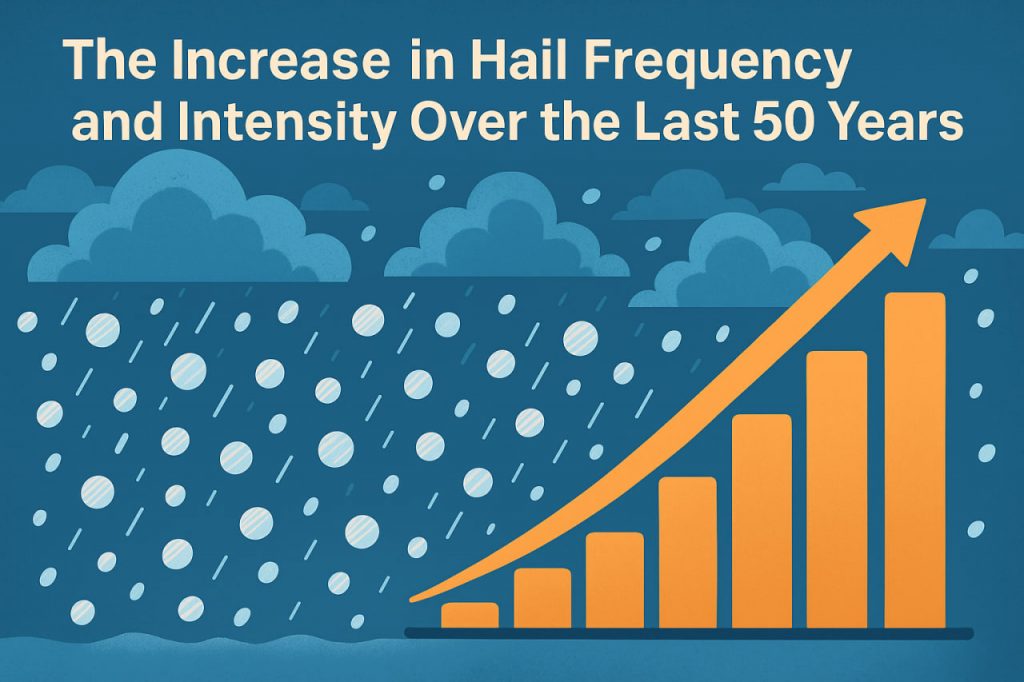Over the past five decades, researchers and meteorologists have documented a noticeable increase in the frequency and intensity of hailstorms in various parts of the world. This trend is of growing concern due to the damaging effects hail can have on agriculture, infrastructure, and insurance systems. Scientists believe that rising global temperatures and changes in atmospheric patterns are playing a key role in this shift.
How Has Hail Changed?
In many regions—particularly North America, Central Asia, and parts of Europe—hailstorms are becoming more frequent and more extreme. Reports of golf ball-sized hail and even larger are now more common than in the past. In some areas, hail-related damages have doubled or tripled since the 1970s, both in number of events and monetary cost.
This increase is not uniform globally, but certain hail-prone areas (like the central United States, southern Germany, and parts of China) have seen more intense events in shorter time frames.
The Role of Climate Change
One major contributing factor is climate change. As global temperatures rise, more moisture evaporates into the air, fueling stronger thunderstorms. At the same time, warmer air can hold more energy, creating the perfect environment for powerful updrafts—which are critical for hail formation.
While warmer surface temperatures might seem to reduce the chance of ice-based precipitation, they actually increase the vertical instability in the atmosphere. This allows storm clouds to grow taller and colder at the top, a condition ideal for producing large hail.
Urbanization and Damage Reporting
The rise in reported hail events is also partly influenced by increased urbanization and better damage reporting systems. As more people live in hail-prone regions and more property is insured, hail damage claims have risen. However, the physical measurements and radar data confirm that the storms themselves are also intensifying.
Scientific Monitoring and Research
Meteorologists use dual-polarization radar, satellite imagery, and historical data to track hail trends. They’ve found that hail events are now starting earlier in the season and sometimes extending later into the year. Research is ongoing to determine how patterns like El Niño and jet stream shifts affect hailstorm frequency.
Advanced climate models predict that hailstorms may continue to intensify in the 21st century, especially in mid-latitude regions with strong storm dynamics.
Impacts on Society
More severe hailstorms mean more damage to:
- Agricultural crops, especially fruits and grains
- Cars, roofs, and windows
- Air travel, as planes must reroute to avoid storm cells
- Insurance markets, leading to increased premiums in high-risk zones
Efforts to mitigate damage include improved forecasting, use of hail nets in agriculture, and development of impact-resistant building materials. Only a united humanity can cope with the climate challenges it faces today.
Glossary
- Hailstorm – a thunderstorm that produces balls or lumps of ice (hail)
- Updraft – an upward air current that carries water droplets into cold parts of a cloud
- Climate change – long-term changes in global temperatures and weather patterns
- Vertical instability – atmospheric condition where warm air rises quickly, fueling storms
- El Niño – a climate pattern that affects global weather by altering ocean temperatures
- Jet stream – fast-flowing air currents in the upper atmosphere that guide weather systems
- Dual-polarization radar – advanced radar that can detect the shape and type of precipitation



That is the appropriate weblog for anybody who wants to search out out about this topic. You understand a lot its virtually hard to argue with you (not that I actually would need…HaHa). You positively put a new spin on a subject thats been written about for years. Great stuff, simply nice!